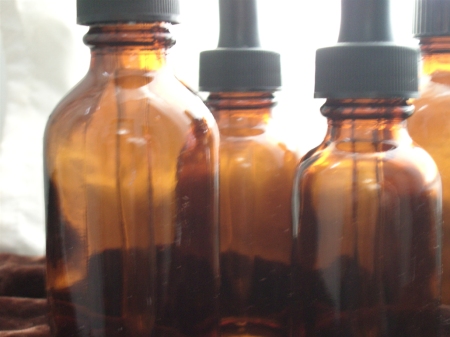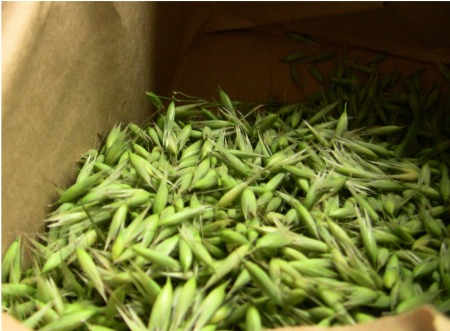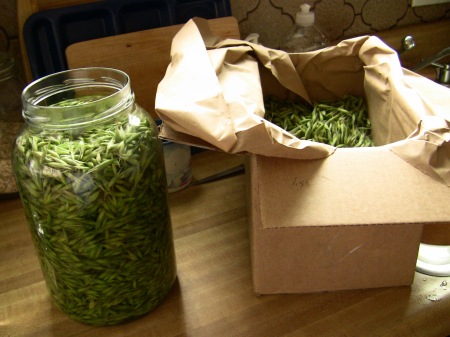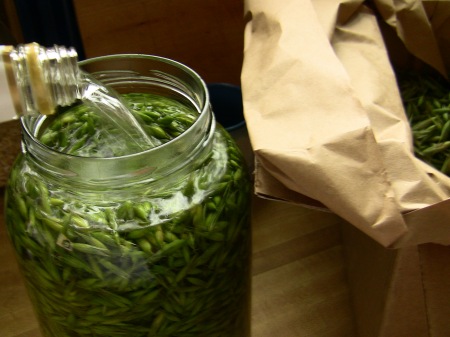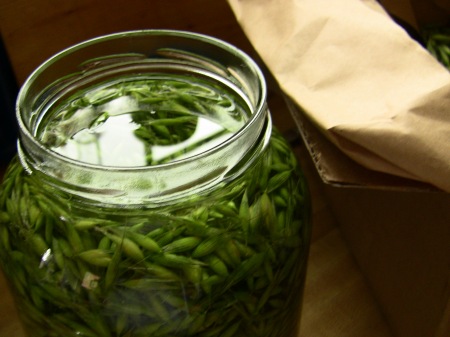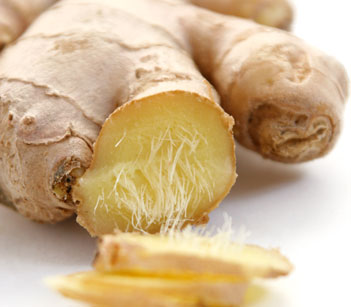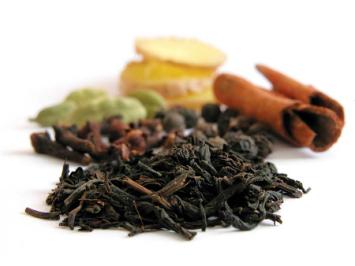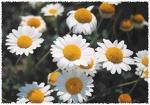 While the cool weather lingers, here in the early months of Spring, out comes the milk pot. I adore my Swiss-made red-enameled milk pot. To me, it means steaming hot frothy milky beverages that when poured, will not result in a milky mess all over the stove top or counter. To my daughter Maeve, Mr. Milk Pot means “vanilla milk”, “cinnamon milk”, “honey milk”, or “hot chockie”. To me, it means any number of milky beverages. Let me give you an example. Back in January, I made a fresh batch of organic lavender infused organic honey for ecoknits, a wonderful etsian who makes the most adorable little hats. Anyway, at the end of the process, I was left with a mass of organic lavender buds soaked in the most lovely clover honey you’ve ever tasted. My thought? Mmmm..this would be good in warm milk. I thought, why not throw in some organic fair trade earl grey tea while I’m at it? So I did. I let the milk come up to a near-boil (but not), called “scalded milk”. You can tell when it’s right because you see this hint of frothiness around the edges of the pot and the milk has not yet come to a simmer/boil.
While the cool weather lingers, here in the early months of Spring, out comes the milk pot. I adore my Swiss-made red-enameled milk pot. To me, it means steaming hot frothy milky beverages that when poured, will not result in a milky mess all over the stove top or counter. To my daughter Maeve, Mr. Milk Pot means “vanilla milk”, “cinnamon milk”, “honey milk”, or “hot chockie”. To me, it means any number of milky beverages. Let me give you an example. Back in January, I made a fresh batch of organic lavender infused organic honey for ecoknits, a wonderful etsian who makes the most adorable little hats. Anyway, at the end of the process, I was left with a mass of organic lavender buds soaked in the most lovely clover honey you’ve ever tasted. My thought? Mmmm..this would be good in warm milk. I thought, why not throw in some organic fair trade earl grey tea while I’m at it? So I did. I let the milk come up to a near-boil (but not), called “scalded milk”. You can tell when it’s right because you see this hint of frothiness around the edges of the pot and the milk has not yet come to a simmer/boil.
 Some tea shops, such as Infusion, an independent coffee shop in Mt. Airy (Philadelphia) has been making tea-infused milk drinks, called cambrics, for years. Other places have more recently introduced the tea latte, an infusion of tea in water, made extra strong and topped with lots of steamed milk (i.e. frothiness at its best). I love steamed milk. (I’m a steamed milk nazi because I worked at a coffee shop in Dublin for three months and was forced to master the skill, but that’s another story. I digress.) The ones who own the origin of the true tea latte are the ancient Indians, I guess, as milk is considered to be a perfect food in India. “Masala Chai tea“, or what I think of as “yogi tea” is a blend of black tea and energetically warming, aromatic spices such as cardamom, cloves, cinnamon, ginger root, and pepper traditionally infused (via heating to a near simmer or simmer) in milk and water for a warming, soothing drink. Other possible additions include saffron, nutmeg, and even rose petals, depending on the region of India. That said, you can experiment with this concept. Lavender and black tea or earl grey (bergamot-flavored) tea are sublime with milk, as is black currant flavored tea. One of my favorite tea blends is my “Sunrise Sunset“, which includes red rooibos ‘tea’ (an herb, really), rose petals, hibsicus, cloves, cinnamon, and a touch of orange peel, an herbal tisane which is superb when prepared with warm milk and honey. I also love herbal root blends prepared with a mixture of water and milk, such as my Ishtar tea (shatavari root, ashwaghanda root, dandelion root, burdock root, and cinnamon bark), or even just a mixture of Shatavari root and cinnamon bark. It is a nourishing, vata-clearing tonic that is so very nourishing to the spirit as well.
Some tea shops, such as Infusion, an independent coffee shop in Mt. Airy (Philadelphia) has been making tea-infused milk drinks, called cambrics, for years. Other places have more recently introduced the tea latte, an infusion of tea in water, made extra strong and topped with lots of steamed milk (i.e. frothiness at its best). I love steamed milk. (I’m a steamed milk nazi because I worked at a coffee shop in Dublin for three months and was forced to master the skill, but that’s another story. I digress.) The ones who own the origin of the true tea latte are the ancient Indians, I guess, as milk is considered to be a perfect food in India. “Masala Chai tea“, or what I think of as “yogi tea” is a blend of black tea and energetically warming, aromatic spices such as cardamom, cloves, cinnamon, ginger root, and pepper traditionally infused (via heating to a near simmer or simmer) in milk and water for a warming, soothing drink. Other possible additions include saffron, nutmeg, and even rose petals, depending on the region of India. That said, you can experiment with this concept. Lavender and black tea or earl grey (bergamot-flavored) tea are sublime with milk, as is black currant flavored tea. One of my favorite tea blends is my “Sunrise Sunset“, which includes red rooibos ‘tea’ (an herb, really), rose petals, hibsicus, cloves, cinnamon, and a touch of orange peel, an herbal tisane which is superb when prepared with warm milk and honey. I also love herbal root blends prepared with a mixture of water and milk, such as my Ishtar tea (shatavari root, ashwaghanda root, dandelion root, burdock root, and cinnamon bark), or even just a mixture of Shatavari root and cinnamon bark. It is a nourishing, vata-clearing tonic that is so very nourishing to the spirit as well.
I am sure my readers will come up with all kinds of beautifully creative ways to infuse milk and create lovely winter treats for both themselves and their children. I want to hear about them! In the meantime, you can start with my lavender and black tea milk (and keep in mind that you can infuse the milk you use to make chocolate pudding, cream of wheat, oatmeal…you name it!). If you use tea leaves or herbs in your milk, you will need to use a fine mesh strainer to strain out the organic material from the milk as you pour into your mug. In the photos for this post, I just used cinnamon sticks and honey in the milk, so a strainer wasn’t really necessary.



RECIPE: Lavender & Black Tea Infused Milk
1 tsp lavender blossoms
1 Tbsp. black tea (darjeeling, english breakfast, earl grey)
1.5 cups whole milk
Put all of the above in a milk pot or small saucepan and starting at medium heat, bring slowly to warmth, removing from heat before boiling/simmering. You will see a softening, frothiness around the edge of the milk, and a gentle steam will be rising from the milk. Add honey if desired!
Want to know more about my thoughts on milk nutritionally? Read on. If not, stick to the recipe above and enjoy!
Myth: Saturated fat clogs arteries (i.e., “whole milk is bad”)
Truth: the fatty acids found in artery clogs are mostly unsaturated (74%) of which 41% are polyunsaturated (Lancet 1994 344:1195)
Sally Fallon is an important figure in the Weston Price Foundation, a non-profit organization that advocates the nutritional (dare I say, evidenced-based) philosophy of Weston A. Price, who wrote a fabulous book called Nutrition and Physical Degeneration, which chronicalled his research among various cultural groups in the 1930’s whose diets were still ‘untainted’ by modern foods such as jams, jellies, white (refined) flours and sugars. He discovered that the facial (skeletal) structures, dentition, physical health remained superior generation and generation only when individuals consume nutrient-dense whole foods and fat-soluble activators found exclusively in animal fats. Physical degeneration would appear in only one generation once modern foods were introduced to a cultural group. Sally Fallon, the president of the foundation, wrote a wonderful cookbook called Nourishing Traditions, which outlines much of the nutritional basis of what the Weston Price Foundation advocates for through research, education, and activism. Much of the nutrional ‘message’ is quite opposite to what most dieticians preach, though much of this (peer-reviewed, scientific) research is beginning to gain ground in the public eye. Namely, that saturated fats and cholesterol rich foods are not at all the enemies they are made out to be, and are, in fact, vital to a healthy diet. All of this is to say…sigh…that whole milk is good. (P.S. And FYI …soy milk…not so good.)
 Raw Milk Warmer Sally Fallon, Nourishing Traditions
Raw Milk Warmer Sally Fallon, Nourishing Traditions
(2 cups)
1 1/2 cups raw milk
2 Tbsp carob powder
2-4 Tbsp maple syrup OR 1/4 tsp stevia powder
1 tsp vanilla extract
1 tsp chocolate extract
1-2 Tbsp nutritional yeast flakes
Place all ingredients in a glass container and mix well with a wire whisk. Place in a pan of simmering water and stir occasionally until the mixture becomes warm. Do not overheat!
Raw milk is another story, as is the story of cultured milk products and their benefits to one’s health. What are your thoughts about milk?
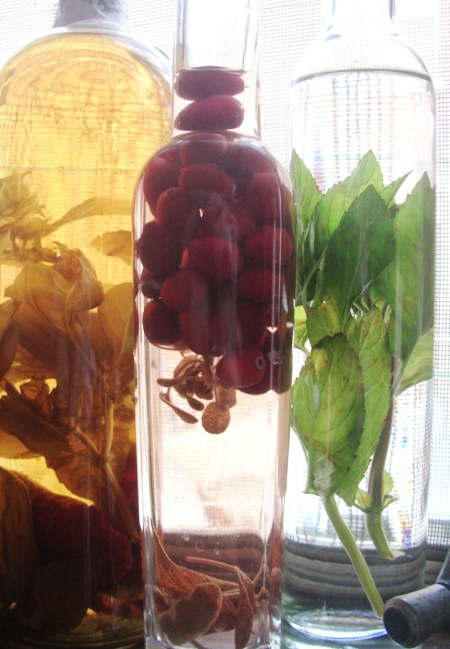
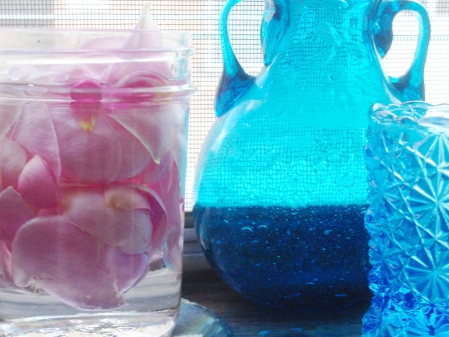 Rose Petal Wine
Rose Petal Wine


 Posted by lilithsapothecary
Posted by lilithsapothecary 
